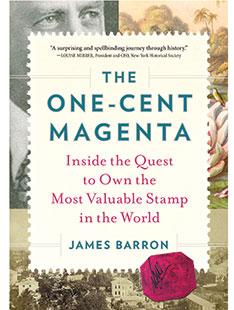The most valuable stamp in the world isn’t much to look at. The one-cent magenta, as it’s known among stamp collectors, was printed in British Guiana (now Guyana) in 1856 as part of a batch of provisional one-cent stamps for newspapers. A hastily constructed reddish scrap with cut corners and smudgy type, it’s battered and faded — hardly the type of object you’d expect to sell for more than $9 million.
Yet there’s an undeniable magnetism to the little stamp, one that New York Times reporter James Barron ’77 discovered when he first began to explore its remarkable saga. In his new book, The One-Cent Magenta: Inside the Quest to Own the Most Valuable Stamp in the World (Algonquin), Barron chronicles the stamp’s journey from British Guiana — where it languished, forgotten, for the first 17 years of its life — to the auction halls of New York City, where it sold for nearly $9.5 million to fashion designer Stuart Weitzman in 2014.
Part of the stamp’s appeal lies in its uniqueness. No other one-cent magenta survives today, a prize in the world of high-end stamp collecting.

But for Barron, the stories behind the one-cent magenta are what made him fall in love with the stamp, beginning with its discovery by Louis Vernon Vaughan, a 12-year-old who found the stamp among his uncle’s papers in British Guiana in 1873 and traded it for 6 shillings, the equivalent of $17 today. “I collected stamps for a year or two as a boy, and the one-cent magenta was the kind of stamp you always dreamed about stumbling upon,” Barron says. “Well, this boy did find the Mona Lisa of stamps, and he didn’t know what he had, so he traded it away. It was probably the worst stamp deal in history.”
After Vaughan traded it, the one-cent magenta made its way to Europe, where it was snapped up by an eccentric French aristocrat just as stamp collecting was coming into vogue. Then it was sold to Arthur Hind, an American industrialist, and finally — after trading hands a few more times — landed in the collection of John du Pont. Du Pont, the troubled heir to the DuPont fortune, tried to offer the stamp to a museum in exchange for a pardon after murdering an Olympic wrestler.
Today, the stamp is on display at the United States Postal Museum, courtesy of Weitzman, who loves collecting one-of-a-kind objects and wanted the stamp to be viewed by the public for the first time. The mystery and drama of its history lend the modest stamp an unquestionable allure. “It’s ephemeral — it wasn’t expected to last very long,” Barron says. “Yet it’s survived all this time, and because it’s a one-of-a-kind item, it’s gone from being quite ordinary to completely extraordinary.”

